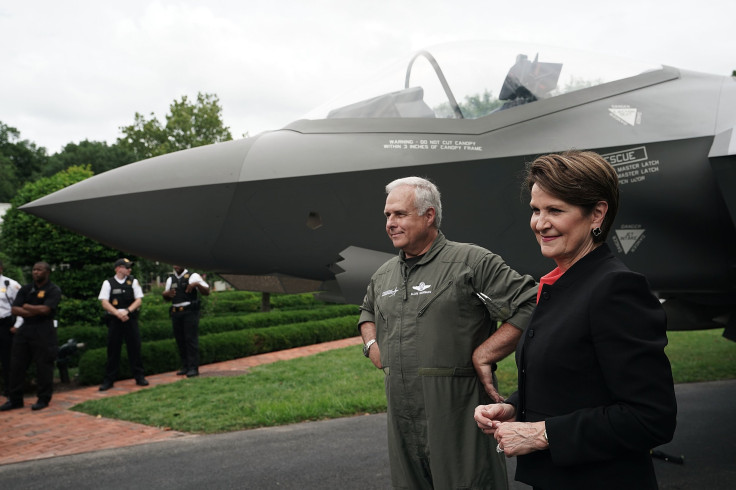Lockheed Martin Moves To Secure $15 Billion Fighter Jet Sale

It's been nearly two decades now since Lockheed Martin (NYSE:LMT) trumped Boeing's bid to build a new "Joint Strike Fighter" for the U.S. military -- a "fifth-generation" fighter Lockheed will keep on building for the U.S. military for the next 50 years, and a fighter that then-Chairman of the Joint Chiefs of Staff Admiral Mike Mullen once called "the last manned fighter" the U.S. will ever build.
This article originally appeared in the Motley Fool.
So why is Lockheed still building F-16s?
The world's most popular fighter jet
For all the success Lockheed has enjoyed selling its new F-35 stealth fighter jets, it's Lockheed Martin's F-16 Falcon that's still the world's most popular fighter jet.
Nearly 20 years after winning the contract to build the F-35, Lockheed Martin is still building F-16s hand over fist. And as we learned last week, it's laying the groundwork to ensure it can keep on building F-16s for decades to come.
You've probably heard about Lockheed's plans to shut down production of the F-16 in Texas, and outsource production to India, right? Well, as Reuters reports, Lockheed's moving right ahead with that plan, and last week proposed to set up a joint venture with India's Tata Advanced Systems Limited to build wings for future F-16s.
It's doing this in furtherance of its efforts to win a $15 billion Indian arms contract to upgrade that country's aging air force (comprising mostly old Soviet MiG and Sukhoi fighters) with shiny new F-16 Falcons. Rivals Boeing, Dassault, Saab, Eurofighter, and Russia's United Aircraft Company are angling to win the same contract, of course. But if Lockheed can plant a large F-16 wing factory in India by 2020, it feels it should have an edge in the competition.
Plan B
I agree. But what if Lockheed doesn't win the Indian fighter contract? What will that mean for investors in Lockheed Martin stock?
Clearly, losing a $15 billion arms deal would certainly be a blow to Lockheed Martin. But whether or not Lockheed wins the contract, there are still strong arguments in favor of outsourcing F-16 wing production -- or F-16 production entirely -- to India.
First and foremost: Cost. Average GDP per capita in India is less than $2,000, according to data from Trading Economics. That's as compared to GDP per capita of more than $53,000 in the U.S. With wages in the subcontinent 25 times lower than in the U.S., it makes good economic sense to relocate F-16 production there, in whole or even just in part.
This is especially true given that the U.S. is switching its fighter jet purchases over to the F-35, and away from the F-16. Meanwhile, foreign nations that are continuing to buy the F-16 will be able to buy even more F-16s if Lockheed can keep the cost low by producing in a low-wage country and shifting production closer to the customer.
Consider where F-16s have been selling lately. Potential purchasers of the plane include not just India itself, but also its neighbor Pakistan. Shift your gaze 2,100 miles to the west, and Bahrain, too, just placed a $1.1 billion order for 16 ultra-modern F-16V Block 70 Falcons -- part of an earlier-negotiated deal that could eventually grow to $3.8 billion in value. Even farther west, Greece, too, is interested in ordering upgrades for its fleet of 85 older F-16s, and Slovakia wants to buy 14 jets of the new F-16V configuration -- for $2.9 billion.
Add it all up, and Lockheed has nearly $10 billion in F-16 contracts in the bag already, whether or not it wins the $15 billion from India. Even for a company the size of Lockheed, with $52 billion in annual sales, this is considerably more than pocket change. And this is just the value of new and upgraded plane sales. There's also the maintenance market to consider. With an installed base of more than 2,200 F-16s in use around the globe, Lockheed has a ready market for new F-16 wings, for example, as old wings wear out.
Between sales, upgrades, and maintenance prospects, I think there's a strong case for Lockheed Martin continuing to produce F-16s and F-16 plane parts -- wherever it wants to.
Rich Smith has no position in any of the stocks mentioned. The Motley Fool has no position in any of the stocks mentioned. The Motley Fool has a disclosure policy.




















